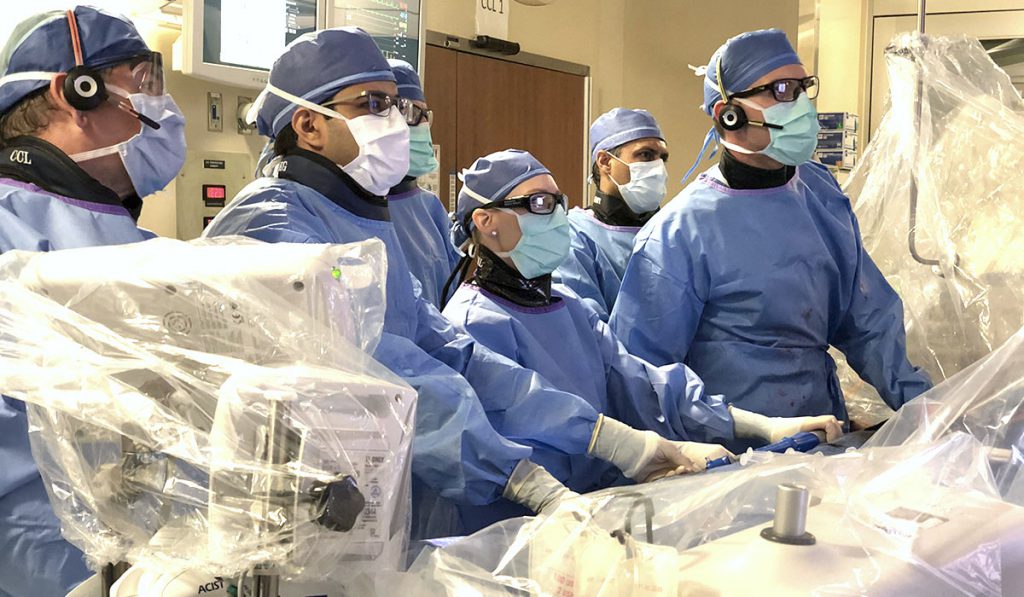Findings of the PARTNER 3 and EVOLUT trials reported at the American College of Cardiology 68th Annual Scientific Session 2019 culminate over a decade of clinical trials testing the safety and efficacy of transcatheter aortic valve replacement (TAVR) compared to surgical aortic valve replacement (SAVR) for the treatment of aortic stenosis (AS).¹ The findings were published in the New England Journal of Medicine in March (PARTNER 3; EVOLUT).
“The earliest trial compared TAVR to medical therapy for patients at extreme or prohibitive risk for surgery, and TAVR was clearly superior. Then, in sequential trials, we compared TAVR to SAVR in patients considered high risk, then intermediate risk, and most recently low risk for surgery,” said Brian R. Lindman, M.D., an associate professor in cardiology and medical director of the Structural Heart and Valve Center at Vanderbilt University Medical Center. “In all cases, TAVR has been shown to be noninferior to SAVR, and, in some groups of patients, TAVR was superior.”
Lindman added, “In the PARTNER 3 trial, we saw a significantly lower event rate at one year in those treated with TAVR compared to SAVR for the composite end point of mortality, stroke or hospitalization, suggesting superiority of TAVR for low-risk patients eligible for a transfemoral approach.”
Interpreting the Trials
“We may be entering a time in which the question for most patients with AS is, ‘Why not perform TAVR?’”
Lindman says the latest trials urge a re-consideration of treatment paradigms for most patients with AS.
“Given the consistent clinical data showing similar if not better results after TAVR, combined with the less invasive approach and quicker recovery that is a patient priority, it’s hard to imagine TAVR not becoming the preferred therapy. We may be entering a time in which the question for most patients with AS is, ‘Why not perform TAVR?’”
Lindman notes, however, that there may continue to be compelling reasons to perform SAVR in some cases. “These trials excluded patients with bicuspid valves or complex coronary disease, and outcomes in the low risk trials only extend out to one or two years. Uncertainty also remains regarding valve durability. However, in higher risk cohorts early clinical findings have tended to remain stable over longer-term follow-up and valve durability has been encouraging.”
Rethinking the Patient Conversation
If TAVR becomes the preferred and more common approach for valve replacement, it will necessitate a new conversation between cardiologists, surgeons and patients with AS.
“For someone referred to a surgeon for SAVR, this raises important questions.”
“For someone referred to a surgeon for SAVR, this raises important questions,” Lindman said. “In 2019, almost all patients ought to be told about the option of TAVR and, in many cases, that approach should be recommended. There should be an evaluation by a multidisciplinary heart valve team and shared decision making with the patient to determine the optimal treatment choice.”
This scenario contrasts with the current National Coverage Determination (NCD) for TAVR that essentially makes SAVR the default treatment option for AS. Under the existing NCD, patients considered for TAVR must be seen by two surgeons who agree that it is a reasonable approach, and that the patient is at least intermediate or high risk.
“There is no corresponding NCD for SAVR,” said Lindman. “This must evolve soon to reflect that we have a series of well-performed randomized trials providing a compelling body of data to inform decisions.”
Confronting Challenges, Optimizing Systems of Care
Lindman is on the writing group for a forthcoming ACC expert consensus document on systems of care for patients with valvular heart disease. Lindman says the paper identifies challenges and opportunities resulting from advancements like TAVR.
One real-world challenge is the smaller number of centers performing TAVR compared to cardiac surgery. “Today, if a patient with AS is referred for SAVR to a center that only performs surgery, that center is incentivized to perform surgery even if the patient is a strong candidate for TAVR and might otherwise prefer it,” Lindman said.
In some regions of the country, a center performing surgery is the only accessible option. “A deliberate, thoughtful increase in the number and location of new centers performing TAVR is likely warranted,” Lindman said. “However, ensuring quality outcomes at centers performing TAVR is also important. Several studies have documented a volume-outcome relationship, albeit a modest one.”
Lindman is optimistic while acknowledging the challenges and important conversations ahead.
“This is an exciting time for the treatment of patients with AS. We now have a less-invasive approach to valve replacement that has been shown across the risk spectrum to be as effective and safe as surgery. In some cases, TAVR is better than surgery. Nevertheless, there is much we still need to learn. SAVR remains an excellent and at times preferred choice in some patients. Cardiologists, surgeons, and the broader heart valve team need to continue to work together and communicate options clearly to patients,” Lindman said.





